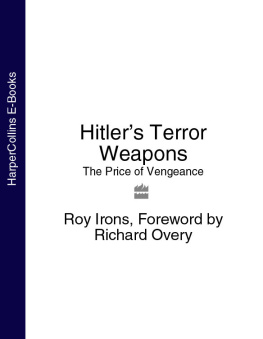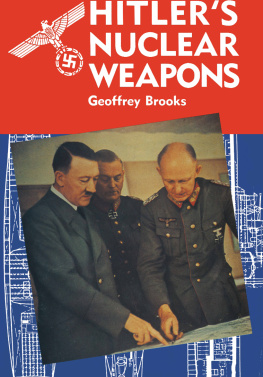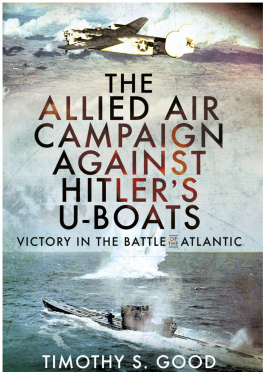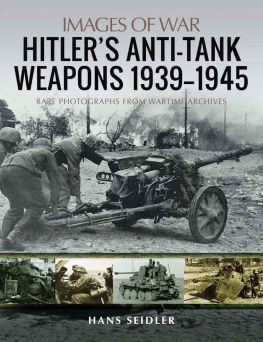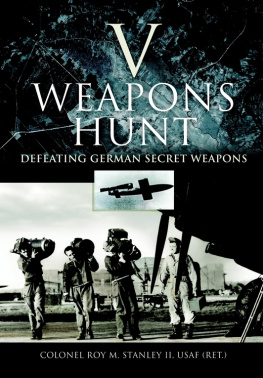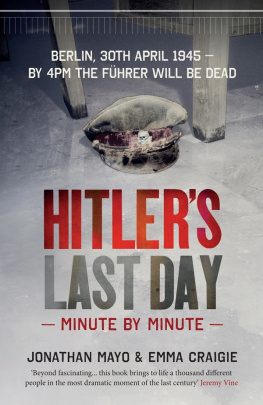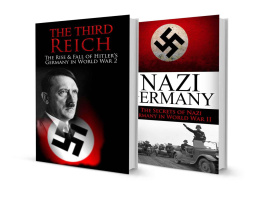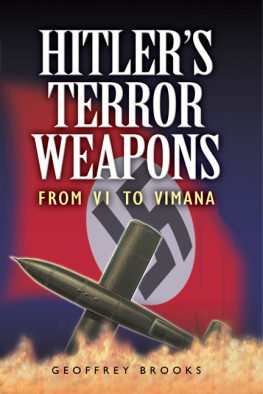This book is dedicated to
Erica Roe Irons
and
Rebecca Ann Irons
Contents
On June 16 1944 Joseph Goebbels Propaganda Ministry sent out a directive to the German press announcing that the first attacks on London with weapons of a new sort would take place that night. It was to be the event of the day for the following mornings front pages. Eight days later the press was told that the weapon would be called the V 1, the V standing for Vergeltung or vengeance. Thus did the German public learn of what soon became the V-weapons campaign.
Ever since the onset of heavy bombing on German cities in 1942 Adolf Hitler had sought some form of terrible retaliation that would force the British and Americans to stop. In the winter of 19434 the German Air Force launched the so-called Baby Blitz on London, but there were too few bomber aircraft to achieve anything of significance against well-organised air and passive defences. Instead Hitler threw his dictatorial weight behind the development of long-range missiles, first the V-1 flying bomb, then the V-2 rocket. Plans were developed to produce them in vast numbers using simple work methods and slave labour supplied by Heinrich Himmlers concentration camps. Some evidence suggests that Himmler was planning to fill the warheads with radioactive waste, but this came to nothing. Instead each missile became an expensive way of transporting modest quantities of conventional high explosives.
The story of the German V-weapons has two sides to it. The British were aware that German scientists were pioneering weapons at the cutting edge of modern military technology. They imagined the worst, and prepared for a new apocalypse, just as they had done in the 1930s in anticipation of German conventional bombing. Until now little has been written about just what the British did to understand, anticipate and combat the new weapons. The account that follows explores not only the warped mindset that drove Hitler to gamble a large proportion of Germanys overstretched war effort on untested technology, but it presents in fascinating detail the twists and turns of British policy in the full glare of the missile threat. Roy Irons gives us the first round in what became the principal feature of post-war superpower confrontation missile threat and anti-missile defence.
It is tempting to suggest on the basis of this candid account exaggerated fears on the one side and expectations on the other that later missile wars might have been different from the terrifying scenarios of nuclear destruction that fuelled the arms race of the 1950s and 1960s. Without the German experiments of the wartime years the post-war missile race would have taken longer anyway. Poor though the strategic gains were for Germany from the V-weapons, the long-run technical gains for the wartime Allies were substantial. It is a peculiar irony that German scientists and engineers working for Hitler ended up supplying the West with the technical means to defend democracy against Communism.
Vengeance, as Roy Irons makes clear, was Hitlers stock-in-trade. The thirst for vengeance in 1919 after German defeat was savagely assuaged in the extermination camps of the Second World War and the search for wonder-weapons of awesome destructive power. What follows is the history of two very different systems fighting very different wars. The V-weapons are in some sense an emblem of Hitlers dictatorship; the British response was the product of a democratic system at war long discussions in committee, many muddled arguments, but enough sensible judgement to get through. In Roy Irons sympathetic and original account the V-weapons campaign becomes not simply a test of technical ingenuity, but a revealing window on the way two very different adversaries made war.
Richard Overy
Kings College
London
My first acknowledgements of debt in writing this book are to my Mother and my Grandmother. The former woke my twin brother and me in the middle of the night to hear the newsflash Hitler is dead, and took us to see the V weapons arrayed in Trafalgar Square in 1946. The latter, when a doodlebug seemed to stop exactly overhead (as they always seemed to do) would quietly and contemptuously smile at Hitlers foolish attempt to steal victory from her beloved England. What child could fail to be impressed by this calm assurance amid the giant clash of little understood arms over London, or by hearing live news of the death of the dreaded tyrant, and seeing the captured weapons themselves, still sinister and impressive amid the triumph of their victims?
I have to thank my good friend Geoff Johnson, a keen and perceptive reader of history, for reading the manuscript; many reader friendly amendments have been made as a result of his observant gaze, including the addition of a diary of events.
The mathematics of bombardment are formidable, and I could only appreciate the work of Dr. Brownowski of the wartime Ministry of Home Security through a glass, darkly. I am in debt, therefore, to John White, who not only spent much time in familiarising himself with the subject, but undertook the heavier task of explaining the implications of it to me, as well as checking the validity of my conclusions from some of the formulas relating to the Battle of the Atlantic; and to David Robinson, of the Royal School of Artillery at Larkhill.
It was my good fortune to begin, on my 55th birthday, a degree in War Studies and History at Kings College London. I was able to attend lectures by Andrew Lambert on naval affairs, Brian Holden Reed on the American Civil War, Michael Dockrill on Modern Warfare and Richard Overy on Germany 1914 to 1945. If the discerning reader should observe that I fall below the standard of these gifted academic authors, he or she will more correctly attribute this to my deficiency in absorbing, than to theirs in imparting, knowledge.
I must acknowledge a vast debt to Richard Overy in the writing of this book. Professor Overy has not only read the manuscript through, offering invaluable guidance and comments, and written the foreword, but had previously offered advice for researching the V2, which formed the dissertation for my degree.
The patience and kindness of Julie Ash and of all of the staff of the Public Record Office at Kew have added to the pleasure of research. To read the files is to be transported back to a brave and anxious age of war, whose uncertain issue was hanging on great events that were always, at the time of writing, in the future. To be able to descend on this age from your world of the future, and to attempt to analyze it, is to me, as exciting as if I had really travelled in a time machine; and the walk to Kew Gardens station afterwards, beneath the low thunder of computerised jet aircraft, is to be transported back to the present; to muse, perhaps as they did, on the uncertain future, when the fears and actions of our own age will be analyzed, with the value of hindsight, from the twenty second century and beyond.
I must also acknowledge the patience, kindness and expertise of the staff of the reading room and the photographic archive at the Imperial War Museum, from whom nearly all the photographs in this book have been obtained. The Museum has the most complete copy of the United States Strategic Bombing Survey outside the United States, and was the only place where I was able to locate a copy of Hoelskens excellent V Missiles of the Third Reich. This work, together with Michael Neufelds The Rocket and the Reich, Benjamin King and Timothy Kuttas Impact, Richard Overys The Air War and Why The Allies Won, John Tolands Hitler, Ralph Manheims translation of Mein Kampf and Herbert Molloy Masons The Rise of the Luftwaffe (which contains a brief but gripping narrative of the events of 1918/19) all of which are detailed in the bibliography, were the most influential of the published sources.

